feature
Big Books Have a Big Impact on Elementary Science Education
Journal of College Science Teaching—July/August 2023 (Volume 52, Issue 6)
By Rachel Hallett-Njuguna
Preservice elementary teachers are faced with the daunting task of learning enough about every subject to support their students’ development of foundational ideas. Teacher preparation programs and professional development providers therefore have the challenge of supporting those preservice and in-service teachers by providing content and methods courses in all core subject areas. These initiatives often put an emphasis on math and reading rather than science, as these subjects are tested most often and serve as the gatekeepers to other content. Infusing a literacy component into a science course for preservice and in-service teachers allows for connections to be made across content areas and supports the initiatives in reading teachers are expected to implement. This article discusses how the Big Book Project provides an opportunity to infuse literacy content, as preservice and in-service teachers in science for educators courses apply their knowledge of literacy to demonstrate their understanding of science concepts in a way that will be palatable to students in their K–5 classrooms.
There is a popular saying attributed to Albert Einstein: “If you can’t explain it simply, you don’t understand it well enough.” Although Einstein was presumably not speaking specifically about elementary science instruction, this quotation captures the struggle teachers face when they attempt to present science content to young children. Many elementary teachers lack exposure to science content during their college careers. Researchers are aware that most elementary teachers have more comfort with language arts rather than science (Brunner & Abd-El-Khalick, 2020; Marco-Bujosa & Levy, 2016), so they suggest that teacher educators should play to these teachers’ strengths to break down barriers to science instruction. When asked to participate in the development and critique of curriculum resources, elementary teachers have shown skill in finding and making materials that worked for their students (Forbes, 2011). Therefore, in science methods courses involving elementary teachers, giving these teachers the opportunity to create tools in the course, rather than simply receive resources, is an option for developing content knowledge.
Science instruction should begin with children as early as possible. It is therefore imperative that teacher educators work on teachers’ science content knowledge prior to their first day in the classroom, then continue to support them through their careers. Preservice program faculty members have tried various methodologies to increase elementary teachers’ content knowledge while improving their confidence in teaching science (Long, 2019). Additionally, research-focused college programs to support the development of content literacy by focusing on the language of the discipline (Siffrinn & Lew, 2018). Focusing on literacy strategies allowed the elementary preservice teachers in the programs to overcome their lack of confidence in science instruction by focusing on their confidence in reading instruction.
Literacy and science
Research on literacy during the elementary years has two main threads that are mistakenly used interchangeably (Grysko & Zygouris-Coe, 2019). Content literacy—the application of reading skills and strategies for the comprehension of texts across content areas—has been the focus of elementary teacher education. Disciplinary literacy—the use of discipline-specific skills and strategies that consider the unique demands of different content areas—has begun to take hold in recent years (Cervetti, 2021; Grysko & Zygouris-Coe, 2019). Grysko and Zygouris-Coe (2019) note that in science in particular, developing disciplinary literacy provides a solid foundation for future science understanding. Exposing students to a variety of texts at an early age would prepare learners to read, write, and communicate as scientists.
I grounded the Big Book Project that I discuss in this article in the considerations from the literature by asking preservice and in-service teachers in a science methods course to create a Big Book based on a science content standard for students in kindergarten through second grade. With their enlarged text and vivid pictures, Big Books allow the entire class to read together. The content in a Big Book can be fiction or nonfiction. The books tend to have limited text but many pictures to facilitate easier comprehension and retention. Much of the research on the effective use of Big Books in classrooms cites Holdaway (1982) as the foundation for using what he called shared book experiences with young children. Holdaway notes that story time and reading time are inherently perceived differently by children. The goal of the Big Book Project was to replicate the powerful “bedtime story cycle” (Holdaway, 1982, p. 298) in the classroom to encourage students to not only listen to the text but also participate in reading. The three criteria that Holdaway developed were as follows: (i) The books needed to be engaging to children; (ii) the books should have visual impact from far away; and (iii) the teacher would need to present a book as more of a performance than a presentation.
From the beginning, Big Books served multiple purposes for the teacher: to support general reading skills and strategies as content-literacy tools and to support deeper understanding of scientific content by providing unique, discipline-specific language and structure. Research suggests that creating a bridge between content literacy and disciplinary literacy could result in more effective student learning experiences (Cervetti, 2021). Due to their image-heavy nature, Big Books support research-based literacy strategies as valuable uses of time in science instruction. Some literacy strategies, as proposed by McGlynn and Kelly (2018), include using anticipation questions to stimulate thinking, having students generate their own questions based on an image, and creating journal entries in which students react to portions of the text.
Big Book Project
The Big Book Project came at the end of a semester that involved the study of science content standards and nuances of concept progression through the grades. The preservice and in-service teachers in the course learned strategies and concepts that demonstrate the critical components of science instruction for young students. Despite the need for strong content earlier in students’ education, Marco-Bujosa and Levy (2016) note that there is a lack of available and appropriate resources at this level; they explain that current resources go too deeply into the content presented, use language that is much too complex, or present misconceptions that create both confusion and an inappropriate foundation for early learners. Cervetti (2021) notes that disciplinary literacy sometimes overlooks students’ developmental needs and downplays the importance of relevant knowledge needed to understand complex scientific texts. I had two goals for this project: (i) In creating their own Big Books, teachers would address their own gaps in science understanding; and (ii) the resulting Big Books would close the gap in available science literacy resources for students.
The science methods course in which the preservice and in-service teachers were enrolled focused on best practices in science teaching and learning. Topics of discussion included inquiry instruction, standards progression, and how to increase complexity of understanding. Toward the end of the semester, the Big Book assignment connected the science pedagogy concepts with newly learned science content. To begin the task, the preservice and in-service teachers selected one science standard to address in a Big Book format. (The teachers first used our state science standards; in later semesters, the teachers used the Next Generation Science Standards, which were under consideration by our state at the time. The examples shared in this article are aligned to the Next Generation Science Standards.) The teachers discovered that not every science standard is amenable to a literacy-based assignment. The preservice and in-service teachers often selected standards with which they were the most comfortable, but sometimes they chose standards that they knew lacked effective instructional resources.
Although many of the students had used or at least seen Big Books before, most had never considered writing one themselves, so they needed some guidance. The students used a sample template (Figure 1) and an example of what the basic brainstorming could look like (Figure 2). To spur creativity, I shared that a high school teacher had used the sample template and brainstorming activity previously when they volunteered to pilot the project with their chemistry and biology classes. The Big Books that the high schoolers created had been shared with local elementary schools for teachers to use with their classes. One of the Big Books created by a high school student (Figure 3), for example, instantly became a favorite among the teachers in the district and was eventually added to the district-created instructional plan for second-grade science. This Big Book, Meet the Matters, tells the story of the Matters, a family in which the dad is a solid, the mom is a liquid, and the baby is a gas. The dad struggles to come to terms with his baby, who moves all over the place and spreads out to fill up the room he is in. Thankfully, the dad learns (with some help from the mom) to appreciate the family’s differences. The district teachers responded well to the creativity used to address this typically mundane topic. How much easier would it be for second graders to remember the differences in the properties of solids, liquids, and gases by relating to this family instead of reading a textbook page that shows particles inside containers?
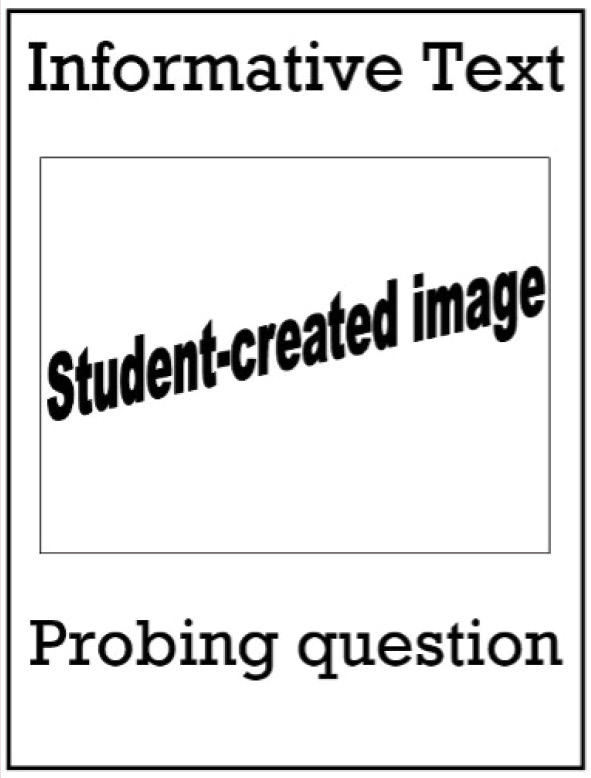
Sample Big Book page template.
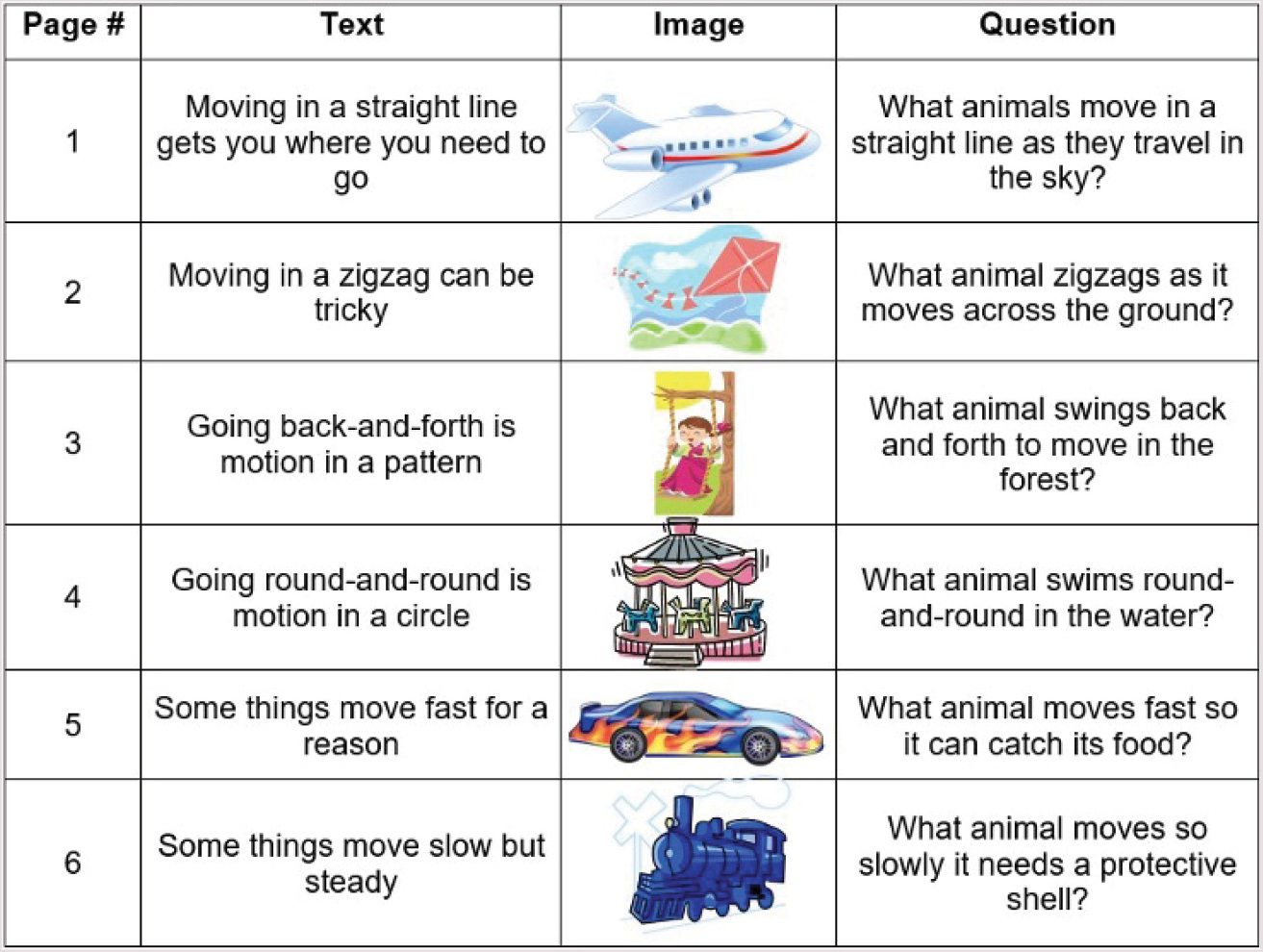
Sample Big Book brainstorming.
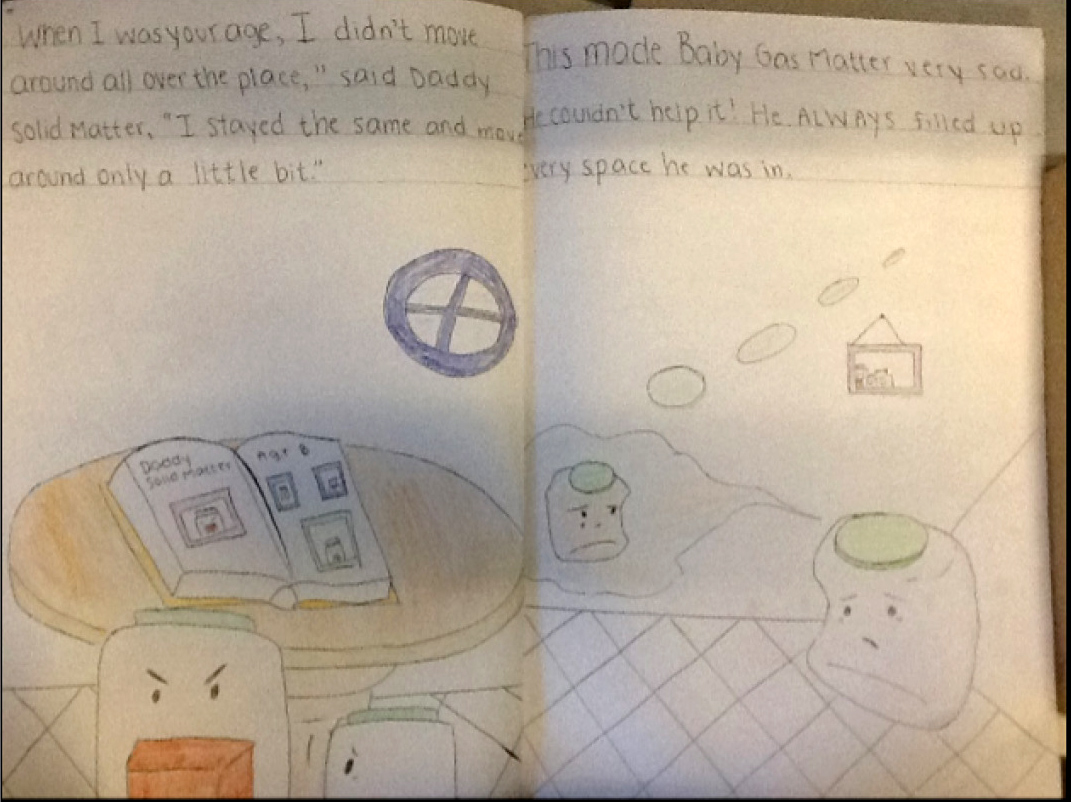
High school Big Book example.
Note. This Big Book, Meet the Matters, covered the standard 2-PS1-1 Matter and Its Interactions, in which students should plan and conduct an investigation to describe and classify different kinds of materials by their observable properties (NGSS Lead States, 2013).
I explained to the preservice and in-service teachers that the resounding positive response to the Big Books created by the high schoolers had been the impetus for expanding the project to college-level classes. If a 15-year-old could create a meaningful science text for younger students, imagine what a trained educator could do. By applying best practices for teaching, I provided the students with a rubric (Figure 4) so they could understand the expectations. The task encouraged creativity but necessitated caution because the Big Books would be intended for use with students in kindergarten through second grade. This grade range challenged the teachers to keep the content at the expected level of the standard rather than go too deep. Even though the book would be read aloud by a teacher, the preservice and in-service teachers were told to keep the reading level as close to the students’ abilities as possible so that they could easily process and participate. This requirement provided another challenge because the inclusion of science vocabulary terms often raises a text’s readability level.
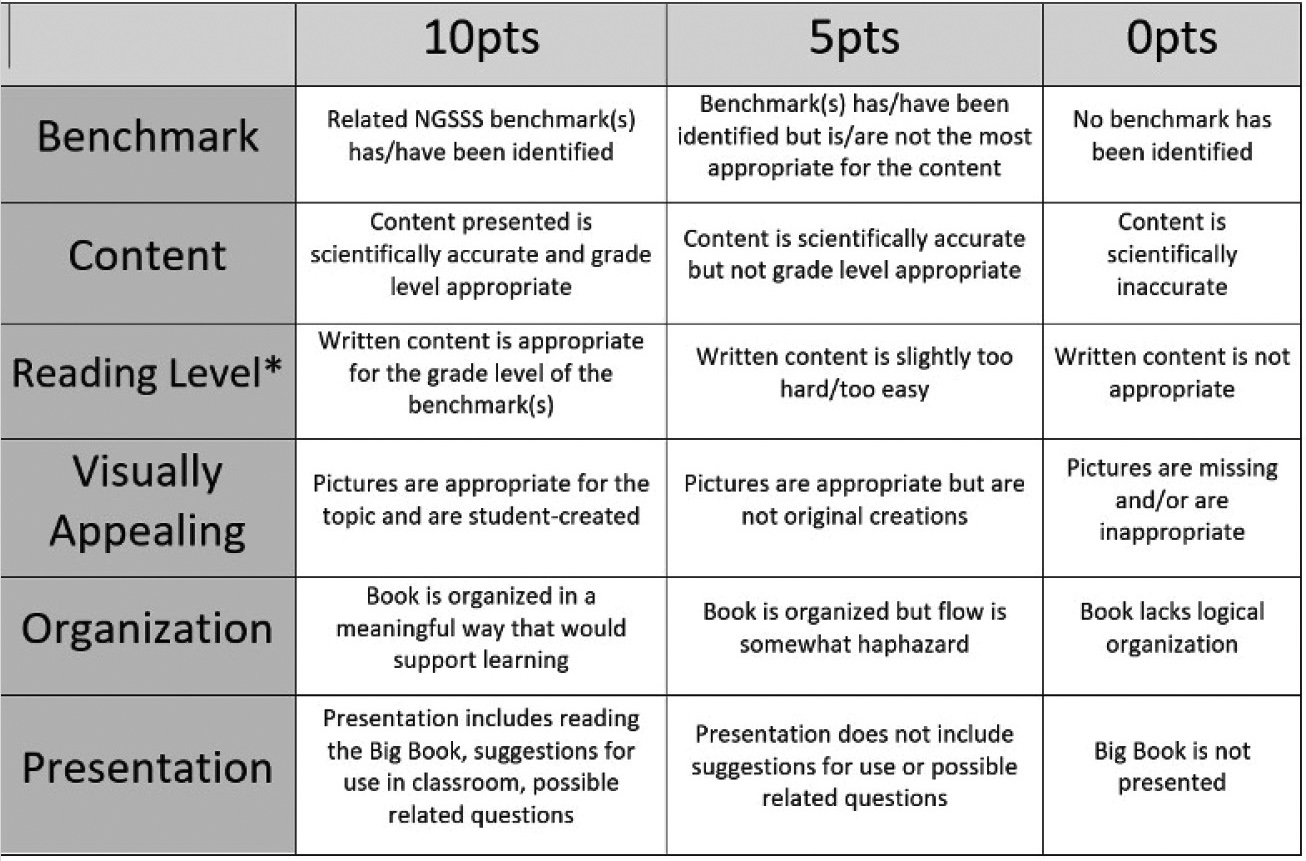
Big Book assignment rubric.
With the freedom to be creative but facing restrictions on content, the teachers at times struggled to produce functional Big Books. Sometimes the content was presented in a way that would not facilitate any of the discussion that research suggested is critical to student understanding; in other situations, the book focused too heavily on text rather than images, making it difficult for younger readers to follow along. Frequently, however, the teachers anecdotally reported that the act of making the Big Book was useful in the development of their science understanding. The task forced them to consider the foundational concepts for topics such as force, motion, states of matter, and living things. They realized, for example, that students needed to firmly grasp ideas like the difference between a push and a pull before delving into Newton’s laws, or that recognizing that offspring look like but are different from their parents is crucial to later comprehension of genetics. My goal of improving elementary teachers’ science content knowledge was therefore achieved. A crucial part of this project involved having the teachers present the Big Book to their peers by reading it aloud and explaining where the book would go in a lesson sequence.
During the semester, the class used the BSCS 5E Instructional Model for developing lessons and units. This instructional model has been used for decades to support science understanding at the deepest levels and was recently updated to include the expectations of the Next Generation Science Standards (Bybee, 2019). Although the model is not linear, it typically begins with an Engage task, such as a video or formative probe, to determine students’ pre- or misconceptions and motivate the students to learn more. Once the students are engaged, the teacher provides an opportunity to explore (Explore phase) by giving all students a common experience on which they can build their understanding, such as a digital lab, hands-on lab, or collaborative activity. Critically, the Explore phase is not a time when teachers should expect all students to have complete understanding of a topic. Teachers should use the Explore activity as a baseline or level-setting task that is referred to and built upon throughout the learning process.
The portion of the 5E model that can be misunderstood is Explain. Teachers often feel the need to stop the learning and take over with a lecture. Although direct teaching is relevant during the Explain phase, the more powerful expectation is to have students construct their current meaning in some way through tasks such as whole-class discussion, collaborative discussion, or interactive note-taking. The nonlinear aspect of the 5E model comes into play often during the Explain phase. If a teacher finds that the majority of the students are not where they need to be in their understanding, it is entirely appropriate to add additional Explore opportunities because moving forward without students having a solid foundation is not instructionally sound. Only once students have a firm understanding of the basics should the teacher move on to the fourth phase, Elaborate.
Time is the enemy of elaboration, though, and with limited time for a unit, there is not always enough time to stretch student thinking further as this phase suggests. In a recent reflection, Bybee (2014, p. 12) noted that Elaboration “centers on the transfer of learning combined with the application of knowledge.” Allowing students to develop deeper understanding and apply their knowledge in novel ways such as conducting open-ended labs or investigating research questions are critical to cementing long-term understanding and retention. In some versions of the 5E cycle, Evaluate is shown at the end of the rotation, after all the other stages are complete and just before starting a new round of learning. In other versions, Evaluate is at the center, the core that drives the other stages—I have found this version to be the most powerful. Using a variety of formative assessments before and during the unit in addition to the summative assessments allows the teacher to monitor students’ progress toward mastery before it is too late, thus ensuring the effectiveness of the instruction.
In line with the Next Generation Science Standards (NGSS Lead States, 2013), throughout the 5E process, students are “gathering, reasoning, and communicating information” (Bybee, 2019, p. 9). My goal for the Big Book Project was therefore to decide where in the learning model a Big Book would fit best (knowing that there is no right answer). Some teachers, for example, used it as a hook during the Engage portion of the lesson, others as a summative assessment during the Evaluate phase, and still others to develop content during the Explore phase. Planning for the use of the Big Book offered an additional opportunity for the teachers to assess a resource’s usefulness, which, as mentioned earlier, is a key skill for all elementary teachers, particularly in science. After their presentation, teachers were encouraged to provide feedback to one another and self-reflect. By giving teachers the opportunity to share and experience these newly created Big Books, the course successfully addressed the gap in appropriate science literacy resources.
Sharing beyond the course
The issues of elementary teachers’ confidence in presenting science content and the lack of appropriate literacy resources that support science learning are bigger than one university’s elementary education courses can address. To have a significant effect on elementary teachers’ content understanding and the resources available to them when teaching science, I share this project with a wider audience. To provide some additional clarity, in this section, I offer a look at some of the Big Books and the feedback from myself and the teachers themselves.
Big Book example #1 on heating and cooling
Figure 5 shows a sample from a Big Book that was a bit too direct in how it presented science content. The second-grade standard relates to how matter can be changed through heating and cooling and ultimately requires the students to construct an argument with evidence that some changes can be reversed. Once they arrive in fifth grade, students are introduced to the concepts of physical and chemical changes, but at the second-grade level, the idea of reversing a change lays the groundwork for those more complex concepts. When presenting the Big Book to their peers, the teacher intended to use the book during the Engage phase for the unit, but during the presentation, the teacher realized that this text would not be engaging to read aloud with young children. Typically, Big Books have simple text patterns and memorable characters or visuals that help children tackle complex concepts in a more digestible way. Although this text had a clever rhyming structure, it would not necessarily pique a 7-year-old’s interest. The images were fun but did not create a memorable scene. One teacher suggested using the Big Book during the Explain phase instead to spark some discussion while tackling the term “reversible.”
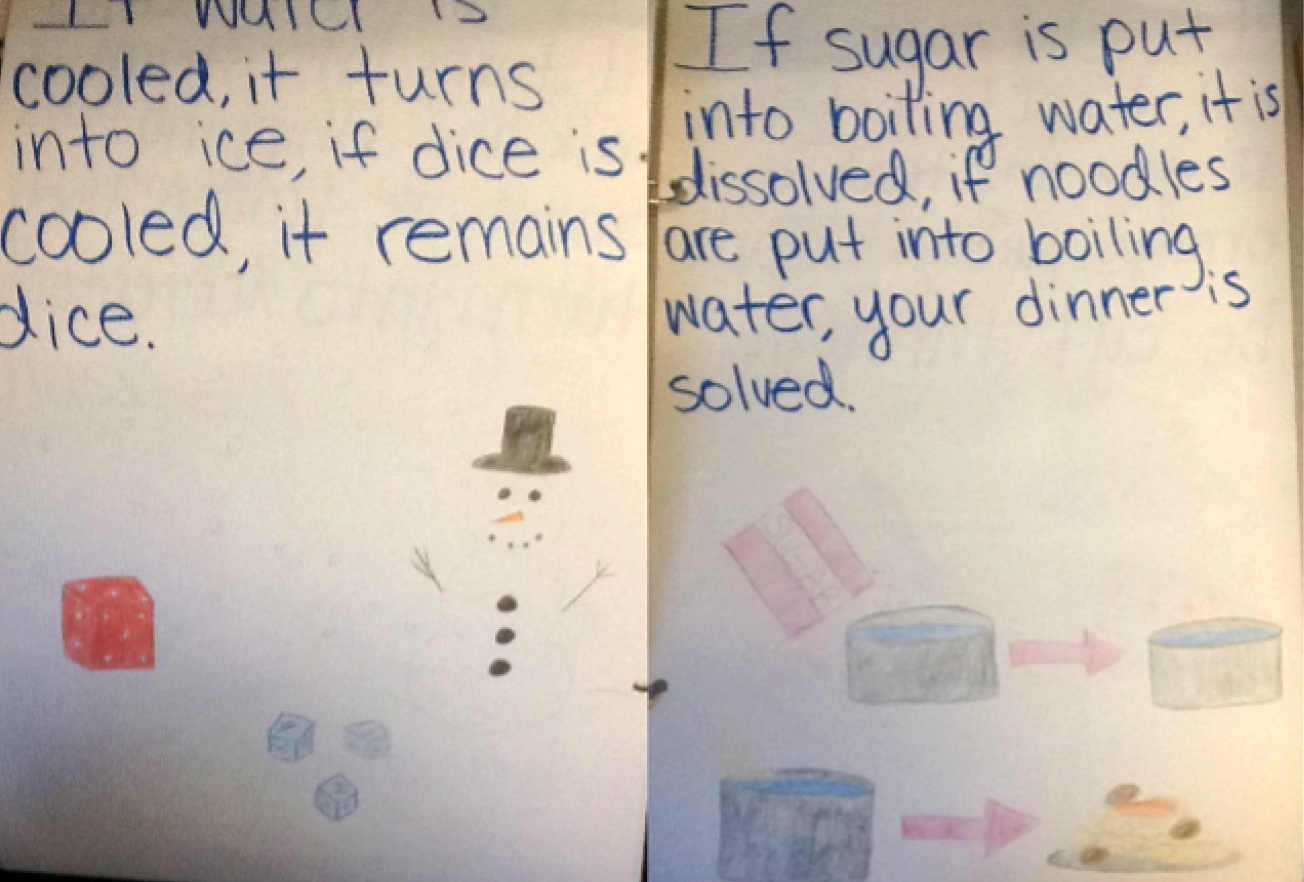
Big Book example #1 on heating and cooling.
Note. This Big Book addresses the standard 2-PS1-4 Matter and Its Interactions, in which students should be able to construct an argument with evidence that some changes caused by heating or cooling can be reversed and some cannot (NGSS Lead States, 2013).
Big Book example #2 on offspring and variation
Figure 6 shows a page from a Big Book on the first-grade standard that covers observing the similarities and differences between parents and their offspring. There were several examples of human parents and children, puppies and older dogs, and, in the image shown, a young plant and a full-grown plant. The images are big and colorful, and students could follow along with the text and then participate in an engaging discussion using the open-ended questions on each page. Including the questions supports the expectation that students would be able to construct an evidence-based account rather than just observe that the plants are different. Resources for this grade level do not always include plants in the discussion of offspring, so this example was a great way to bring in a range of concepts that support deeper understanding. Additionally, the differences in this example are subtle, with the older plant having a few more leaves and dots (seeds) in its center. As a resource to use during the Evaluation phase, this Big Book would serve as a useful diagnostic of young students’ observation skills.
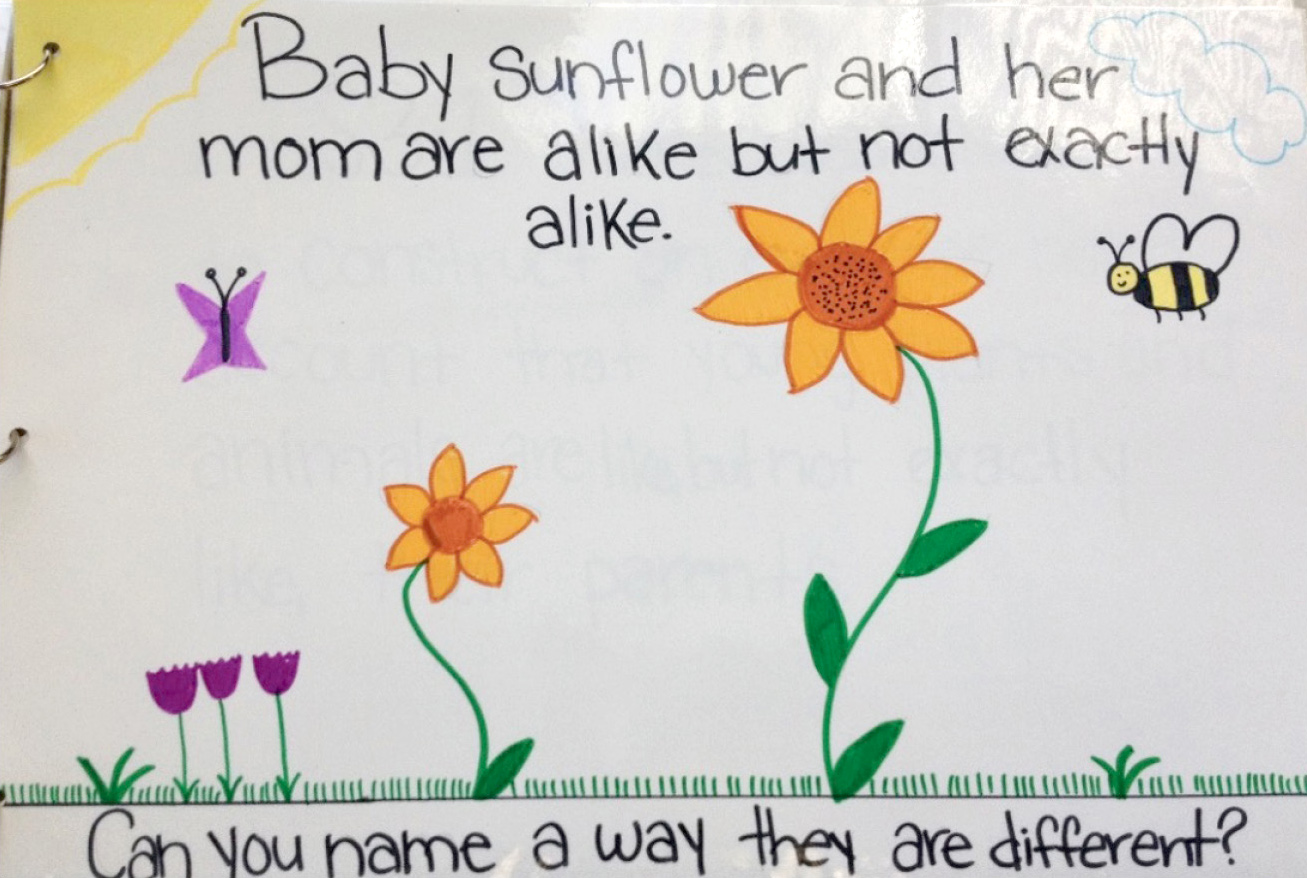
Big Book example #2 on offspring and variation.
Note. This Big Book addresses the standard 1-LS3-1 Heredity: Inheritance and Variation of Traits, in which students should make observations to construct an evidence-based account that young plants and animals are like, but not exactly like, their parents (NGSS Lead States, 2013).
Big Book example #3 on “sink or float”
Technology allows students to create digital books that can be presented on interactive whiteboards, freeing them up to move around the classroom and engage students directly. Creating digital books also led to some valiant attempts at animation, with moving images and embedded GIFs livening up the slides. In one example (Figure 7), the teacher created original artwork and used PowerPoint slides to structure the actual text and book. The second-grade standard asks students to analyze data after testing a material, and the teacher who created this Big Book planned to use it during the Engage phase to encourage students to think about materials and their purposes. The story is about a goat who must cross a moat to see his sick friend, so he needs something that floats. The pages ask questions about the usability of different materials (e.g., the apple that floats but is not big enough for the goat to ride on), which could generate plenty of questions and answers from students. As presented, the Big Book was also intended to serve as the springboard for a hands-on exploration. This Big Book is an exceptional example of how fictional characters can be used to present scientific concepts in a way that sparks interest and does not develop misconceptions.

Big Book example #3 on “sink or float.”
Note. This Big Book addresses the standard 2-PS1-2 Matter and Its Interactions, in which students analyze data obtained from testing different materials to determine which materials have the properties that are best suited for an intended purpose (NGSS Lead States, 2013).
Conclusion
The best evidence of the success of this assignment in developing elementary teachers’ science content knowledge and creating appropriate science literacy resources is that most of the teachers requested to keep their Big Books for use in their classrooms. Their peers also took pictures of the pages to re-create them later. The teachers who selected standards that they either knew they had limited resources for or that they knew they had struggled to teach in the past indicated that they felt encouraged by the results of the project. Digital Big Books were shared among peers to build a library of ready-made resources.
The ultimate intention of this project was not to make teachers think they needed to create resources for every topic they teach. Elementary educators left the course with a more discerning eye regarding the use of science instructional materials because they now had the content knowledge and best practices they needed. I used intentionality in the assignment to empower teachers to improve their knowledge and practices long after the course concluded. By supporting elementary teachers as learners of science, we can ensure that our youngest students will experience high-quality science instruction from the beginning of their educational journeys, and hopefully those students will enjoy learning science for years to come.
Rachel Hallett-Njuguna (rahallettnjuguna@fsu.edu) is an assistant in research at Florida State University’s Learning Systems Institute in Tallahassee, Florida, and a project director for a U.S. Department of Education–funded grant in the School of Teacher Education at the University of Central Florida in Orlando, Florida.
Literacy Teacher Preparation Teaching Strategies Postsecondary


